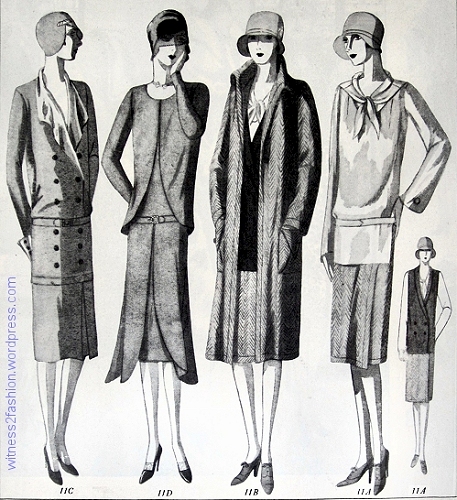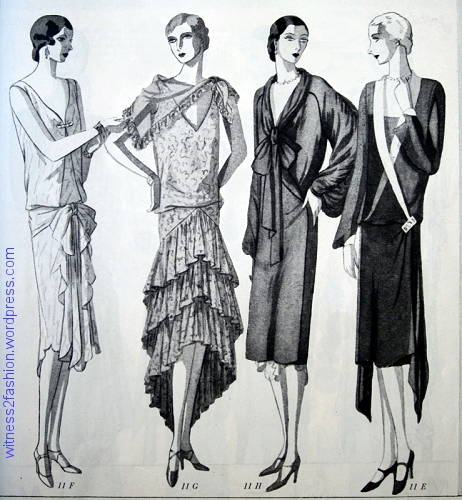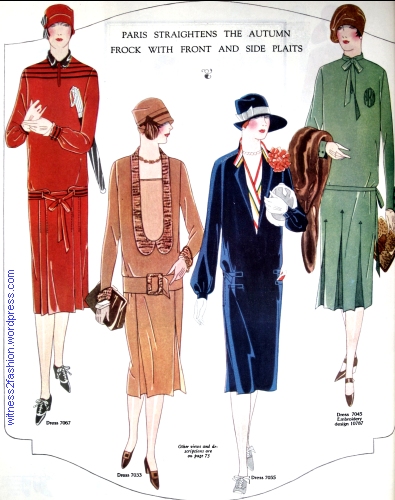
Paris Straightens the Autumn Frock with Front and Side Plaits. Delineator, Sept. 1926.
Pleats for All Sizes
Butterick’s Delineator magazine ran two articles in the September, 1926, issue about the importance of “plaits” [i.e., pleats] to the fall styles. The first article showed three patterns for women in the normal range of sizes, with bust measurements of 32 to 44 inches. Elsewhere in that issue, patterns for “Misses aged 15 to 20 and small women” also show pleated skirts. [Misses’ sizes were for shorter and smaller figures; age 20 assumed a 37″ bust.] But the second article showed dresses with pleats in pattern sizes up to a 52 inch bust measurement. Since the styles of the 1920s were especially cruel to large figures, I am always intrigued by these unexpectedly large pattern sizes. I’m guessing that Butterick and other pattern companies realized that being “hard to fit” is a major reason for making your own clothes, so they routinely offered sizes not available in most stores.
Pleated Styles for Average and Small Women, 1926
In this post I’ll share some of the styles for women who fell within the normal size ranges.

Butterick pattern 7067, September 1926.
This dress is very unusual — at least in my limited experience — because of the horizonal bands which decorate the shoulders and extend onto the sleeve caps. Twenties’ fashions can be hard to wear because they widen the hips — already most women’s widest area. Many twenties styles have vertical details which seek to counteract this problem, but I have not seen many that visually broaden the shoulders like this:  Note, too, that the skirt pleats are stitched down for several inches to control fullness. The belt, which passes through buttonholes in the hip band, is tied very loosely as illustrated, but it could be used to snug the hip and create a blouson above. The long tie ends and the pleats create vertical lines for a slimming effect. This fashion figure is over 9 “heads” tall, but, adjusted to a normal figure, this could be a very becoming — and not terribly difficult — dress to copy. Back views are shown at the end of this post.
Note, too, that the skirt pleats are stitched down for several inches to control fullness. The belt, which passes through buttonholes in the hip band, is tied very loosely as illustrated, but it could be used to snug the hip and create a blouson above. The long tie ends and the pleats create vertical lines for a slimming effect. This fashion figure is over 9 “heads” tall, but, adjusted to a normal figure, this could be a very becoming — and not terribly difficult — dress to copy. Back views are shown at the end of this post.

Butterick 7033, September 1926.
This dress, with its enormous buckle and wide hip band, would not flatter many women — especially those with a 44 inch bust and 47.5 inch hip — the usual pattern proportions. The collar creates a deep curve similar to the line of a long 1920s necklace, but it gets bigger at the bottom and draws more attention to the hip area. The description (“attached to a long body”) suggests that, although described as a dress, this is probably made made as a top, including the hip band, with a separate skirt suspended from the shoulders like a slip — a very common practice. The vestee, which fills in the neckline, can be made detachable for washing.

Butterick 7055, September 1926. For ladies 32 to 48 bust.
Butterick No. 7055 was not singled out as being for larger women, but it was available in sizes 46 and 48. I love the “Roman striped vestee” with its strong diagonals, and the ribbon-flower pom-pom which draws your eye upward to the face, plus the widening effect of “saddle shoulders” cut-in-one with the sleeve. This dress is definitely meant to be snugged at the hip; it has an adjustable belt at each side, like the belt on the back of a vest.  This dress has box pleats lined up with the side seams, and top-stitched for a slim fit over the hips. The saddle shoulders are similarly top-stitched.
This dress has box pleats lined up with the side seams, and top-stitched for a slim fit over the hips. The saddle shoulders are similarly top-stitched.
A dress shown in “pea-soup green” gives plenty of room for movement when you’re walking:

Butterick 7045, September 1926.
Monograms were very popular, influenced perhaps by Jean Patou’s use of them in sportswear. This dress is a bit tricky to make, because it has inserted pleats of darker color fabric. They are not inserted into seams, but added like a wedge-shaped godet. That explains the need for those arrow shapes — stitching or applique? — that reinforce the points of stress. 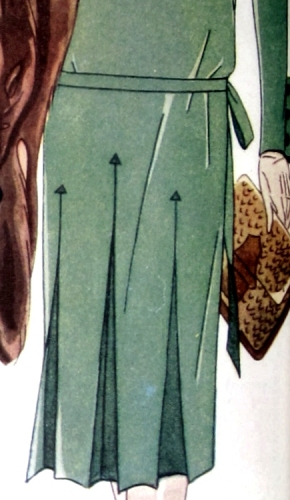
Pleated Dresses for Misses and Smaller Women, September 1926.

Butterick patterns for Misses Aged 15 to 20 and Smaller Women. September 1926.
Butterick 7057, (left) like the green dress pictured above, has pleats inserted like godets. The color combination is interesting. A color called bois de rose (rosewood) was popular, but this dress is burgundy colored. Notice the unusual sleeves. The pink contrasts in the top half of this dress are so interesting that its self-colored hip belt is hardly noticeable.

Butterick 7057 for Misses and Small Women, September 1926.
The pleats are topstitched, both for flatness and to reinforce the weakest points. The “convertible” collar can be worn unbuttoned.
This blue dress also has stitched-down pleats below its dropped waist.

Butterick pattern 7003 for Misses and Small Women, Sept. 1926.
This dress is for younger and smaller women, who might be expected to have ideal 1920s figures, but it still uses many vertical lines for a slenderizing effect, especially in the very long tie. Little capes on the backs of dresses were often shown in pattern illustrations, but, like this one, they were usually detachable or optional. “Chin-chin blue” is probably meant to evoke Chinese colors. The gray belt seems to run through buttonholes in the front and back of the dress. See back views below.
Misses’ dress 7024 is not pleated. Described as a “coat-frock,” it has a slenderizing vertical opening the entire length of the center front.

Butterick pattern for Misses 7024, Sept. 1926.
Lacking pleats, the skirt’s 46″ hem circumference does not encourage long strides. The artist has neglected to draw the slip straps. Another sheer-over-satin dress for young women, No. 6904, was featured in July, 1926:
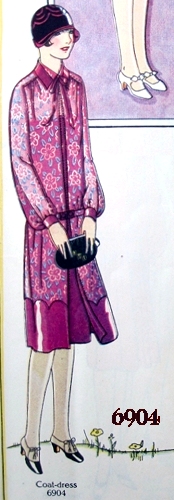
Butterick pattern No. 6904 for Misses, July 1926.
These coat-dress styles create such a strong vertical line that I would expect them to be appealing to larger women, but both these patterns are for “Misses 15 to 20 years old, and small women.”
This dress pattern, No. 7059, is actually a blouse and skirt combination.

Butterick pattern No. 7059 for Misses and Small Women. Sept. 1926
The pleats on the skirt can fall perfectly straight, because there is no waistband; this skirt is attached to a slip-like underbody and hangs from the shoulders. It is similar in style to some of the pleated dresses for larger women described in the same magazine. It is not a style I would recommend to women seeking to look thinner.
These 1920s Hats Deserve a Second Look:
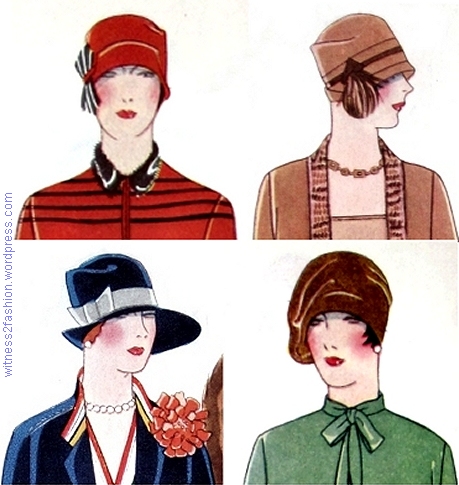
Four hats from Delineator, September 1926.
Here are back views of the eight dresses from September that are pictured above:

Back views: Butterick patterns for Women Nos. 7067, 7033, 7055, 7045.
Most of these dresses can be made with long or short sleeves. Only one, #7033, has pleats in back. #7045 shows that there is a handy strap on the back of her clutch purse.

Back views of Dresses for Misses, Nos. 7024, 7059, 7057, 7003.
Part 2 of “Paris Calls for Pleats” will show 1926 patterns for larger women.
